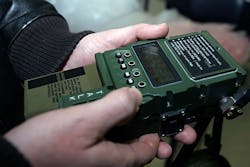Navy sets sights on new combat survivor evader locator survival radio for downed pilots
Officials of the Naval Air Systems Command at Patuxent River Naval Air Station, Md., have released a request for information (242-14-082) for the Next Generation Survival Radio System-NGSR program.
Survival radios are for ships and aircraft for rescue in an emergency. These emergency radios generally transmit on international distress frequencies. Current U.S. aircrew survival radios, however, are aging and require upgrades or replacement with new radios.
To deal with this problem, Navy leaders are asking industry to start thinking about the Next-Generation Survival Radio (NGSR) to replace current versions such as PRC-112B1, PRC-112G, PRC-149/149A, and PRQ-7/7A radios as they expire over the next decade.
Related: Boeing delivers first CSEL radio full-rate production order to the Department of Defense
The Navy's request for information seeks to identify companies able to provide an off-the-shelf Next-Generation Survival Radio System with technologies to improve reliability, maintainability, and availability (RM&A); and enhance survivability.
The new radio system may capitalize on existing survival radio technology to reduce manpower, training, and logistics requirements. Navy officials also want new survival radios that do not require modifications to the current air crew survival vest radio pocket, and that uses non-developmental item (NDI) technology to the maximum extent possible.
The new survival radio should be software defined, with the ability to communicate using one of a variety of waveforms simply by reloading or reconfiguring the software for the necessary application.
The radio also must have combat survivor evader locator (CSEL) capability over the horizon, and should be compatible with planned military satellite communications (SATCOM) systems by software reprogramming.
Related: Air Force orders Combat Search and Rescue radios from General Dynamics
The radio must have a programmable auto activation capability for positive G and salt water immersion, should provide a high system reliability and availability, and use NSA Type I non CCI Suite B encryption.
Companies interested should respond by post no later than 9 June 2014 to Department Of The Navy, Naval Air Systems Command, Contracts Department (Air 2.4.2.2), Bldg. 2272, Suite 256, ATTN: Tyesha Parker, 47123 Buse Road, Patuxent River, MD 20670.
Email questions or concerns to the Navy's Tyesha Parker at [email protected].
More information is online at https://www.fbo.gov/spg/DON/NAVAIR/N00019/242-14-082/listing.html
